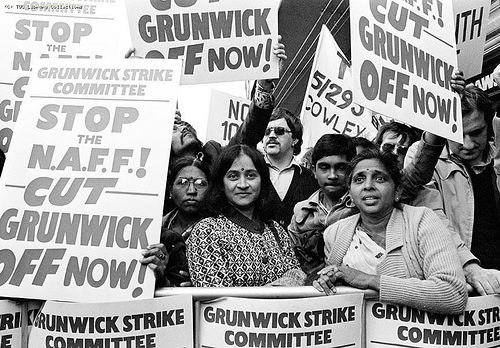Womxn Led Movements : The Spirit Comes Naturally, by Surmayi Khatana
- teenbellemag

- Mar 20, 2020
- 4 min read
Recently, we have seen images of womxn at the forefront of marches and protests erupting across the country and the world. From art-work featuring womxn with their arms raised in protest to poetry and songs chanting their will power. Yet, this is something that should not come as a surprise to us. Womxn have been on the front lines of movements throughout history.
One of the most popular movements in history was set into motion by womxn. A womxn-led demonstration in 1789 led to the beginning of The French Revolution. Poverty, starvation and the rise in the prices of bread led to 7,000 womxn approximately to gather near the city hall in protest and proceeded to march for 6 hours to Versailles while beating a marching drum. Louis XVI did not fulfill their demands and the marchers turned violent. These womxn were dubbed as the ‘Mothers of the Nation’. They managed to bring home wagons full of food and shake the foundations of the Monarchy in France and forced the King to Paris. Womxn have always been politically active, from the feminist idea of ‘personal is political’ to the current waves of protest. In August 1976, London saw a two-year widespread workers strike led by South Asian Womxn. The Grunwick Dispute featured people of different races and backgrounds coming together against the common oppression of unfair working conditions.
Ecofeminism has seen a close relationship between womxn and the environment. The Chipko Movement, for instance, in Uttrakhand, March 1974 was pioneered by Adivasi womxn. Gaura Devi, along with 27 other womxn hugged the trees in the forest to prevent the felling of the trees. This laid down the roots of a large movement against deforestation which continues to date.
In 1985, India saw Medha Patkar as a founder member of Narmada Bachao Andolan. The Andolan is a social movement comprising people from various walks of life, from tribal populations, academicians, environmentalists, scientists, artists, farmers, activists. All coming together protesting against the Sardar Sarovar Dam on Narmada River. The movement has continued into the 21st century in the affected areas of the Dam. Medha Patkar has been at the forefront of many movements challenging casteism and discrimination.
The Anti-Arrack Movement in Andhrapradesh in 1992, saw womxn as the face again. Given that alcohol consumption had direct impacts on them in terms of domestic violence and their families. Vardhineni Rosamma spearheaded the movement. Their demand for the government was to ban the sale of low-cost liquor or arrack.
November 2000 saw the World’s longest hunger strike by Irom Sharmila for 16 years. The Iron Lady began the strike for the abolition of Armed Forces (Special Powers) Act or AFSPA, which provides security forces with the power to search properties without warrants, arrest people, use deadly force based on just suspicion of someone’s motives. The Anti-AFSPA movement in Manipur has continued to grow.
The Womxn’s March in January 2017 in the United States of America saw vast mobilisation, nearly 5 million people. The Womxn’s March along with the #MeToo movement has managed to challenge and change power dynamics across all fronts. The Aurat March in Pakistan from 2018, has been bringing up important issues and simultaneously shaking the patriarchy to the core!
Approximately 2,000 womxn have sat through cold winters on the road in Shaheen Bagh for months, with Muslim womxn leading protests. Posters of Savitribai Phule, Fatima Beevi, Mahatma Gandhi and B.R. Ambedkar put up across the site.
The Pinjra Tod in India has been a major stakeholder in womxn’s student politics. The movement originated as a response against the unjust curfew timings for womxn’s hostels and paying guest houses.
There has been a prevalent narrative of womxn being ‘numbers’ of movements instead of flag bearers. In the aforementioned movements, womxn-led causes that impacted them and also causes that spanned over identities. Given that everything is a feminist issue as the impact it has on womxn will always vary from how the impact follows through on men. Apart from being faces of movements, womxn maintain the skeleton of the movements, for instance in the Warli Revolt, womxn hid rebels, faced police brutality, and passed messages. A similar trend can be seen in the current efforts of womxn mobilizing against CAA and helping with rations, donation drives, and communication.
The patriarchy plays a dual role in womxn’s movements. The struggle against the patriarchy doubles our fighting grounds. For instance, in the Grunwick Dispute the protestors struggled with their fathers and husbands to be able to go out and protest, in a piece titled ‘Risking Gossip and Disgrace,’ in Spare Rib Magazine, the protestors spoke about how the management purposely spread false rumours about ‘boyfriends’ so that the families would stop womxn from going out of their homes. The nature of police brutality in a patriarchal set up is different for womxn. Many womxn have to lie at home to go out and protest.
Nonetheless, given that we have been struggling against the patriarchy throughout our lives, the revolutionary spirit comes somewhat naturally. It really should not astonish people that womxn are out there leading movements-we have been doing it since forever.








Comments